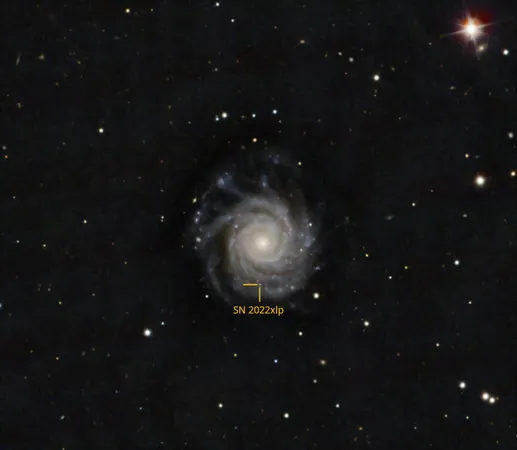
Astronomers Unlock Secrets of Rare Type Iax Supernova
2025-09-22
Author: Wei Ling
Unveiling the Mysteries of SN 2022xlp
In an exciting breakthrough, an international team of astronomers has delved deep into the fascinating world of SN 2022xlp, a rare type Iax supernova. Their findings, published on September 9, promise to enhance our understanding of this unique cosmic event and its implications for stellar evolution.
What Makes Type Iax Supernovae So Special?
Typically, type Ia supernovae occur in binary systems featuring a white dwarf star. These stellar explosions are crucial for astronomers, providing vital insights into the life cycles of stars and the dynamics of galaxies. However, type Iax supernovae represent a distinctive, rarer class within this category, where remnants of the white dwarf remain post-explosion. They are characterized by lower ejection velocities and luminosities compared to their type Ia counterparts.
The Spectacular Discovery of SN 2022xlp
Discovered in 2022 within the NGC 3938 galaxy—which lies an astonishing 72.2 million light-years from Earth—SN 2022xlp was classified as a type Iax supernova shortly after its first observed spectrum. With a peak absolute brightness of -16.04 magnitudes, it stands out as the second intermediate-luminosity Iax supernova ever recorded.
Astronomical Observations Reveal New Insights
Led by Dominik Bánhidi from the University of Szeged in Hungary, the research team embarked on a comprehensive observational campaign, utilizing both ground-based and space telescopes. Their observations began just six days post-explosion and continued for an impressive 73 days. The analysis of the captured images, combined with historical data, revealed a rapid change in color as the photospheric temperature declined, showcasing a remarkable 1.5 magnitude color shift in the weeks surrounding the event.
Drawing Comparisons to Previous Discoveries
Crucially, the team noted that SN 2022xlp bears striking similarities to SN 2019muj, the first known intermediate-luminous type Iax supernova. Their comparative study indicated that brighter Iax supernovae exhibit more substantial color changes, providing further insight into the mechanisms driving these explosive phenomena.
Measuring the Power Behind the Explosion
Delving into the metrics of SN 2022xlp, the astronomers estimated a staggering bolometric flux peaking at 887 duodecillion ergs per second, suggesting the production of about 0.02 solar masses of radioactive nickel. The total energy released during the explosion reached around 20 quindecillion ergs, with an ejecta mass estimated at 0.14 solar masses, highlighting the immense power behind this rare cosmic occurrence.


 Brasil (PT)
Brasil (PT)
 Canada (EN)
Canada (EN)
 Chile (ES)
Chile (ES)
 Česko (CS)
Česko (CS)
 대한민국 (KO)
대한민국 (KO)
 España (ES)
España (ES)
 France (FR)
France (FR)
 Hong Kong (EN)
Hong Kong (EN)
 Italia (IT)
Italia (IT)
 日本 (JA)
日本 (JA)
 Magyarország (HU)
Magyarország (HU)
 Norge (NO)
Norge (NO)
 Polska (PL)
Polska (PL)
 Schweiz (DE)
Schweiz (DE)
 Singapore (EN)
Singapore (EN)
 Sverige (SV)
Sverige (SV)
 Suomi (FI)
Suomi (FI)
 Türkiye (TR)
Türkiye (TR)
 الإمارات العربية المتحدة (AR)
الإمارات العربية المتحدة (AR)